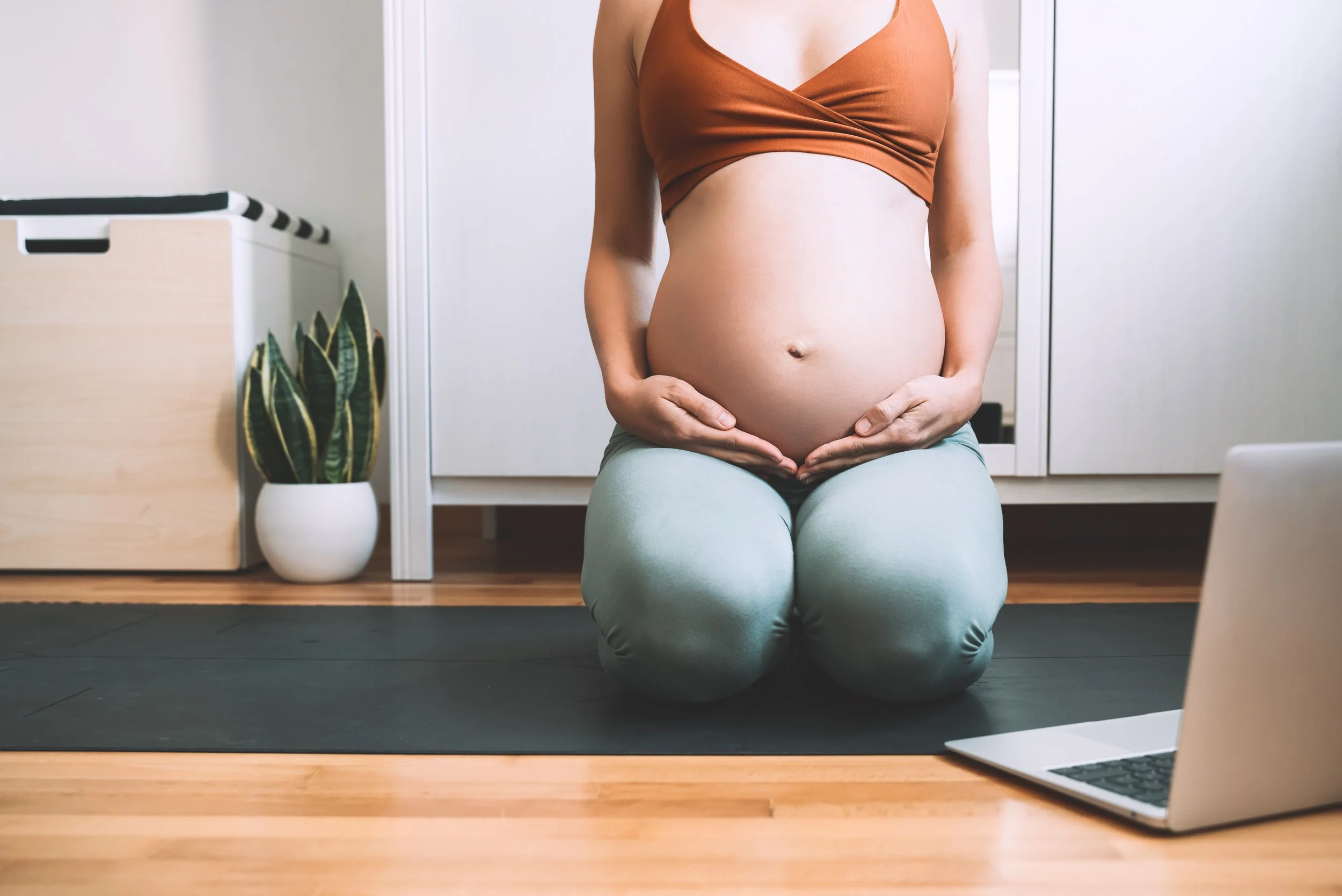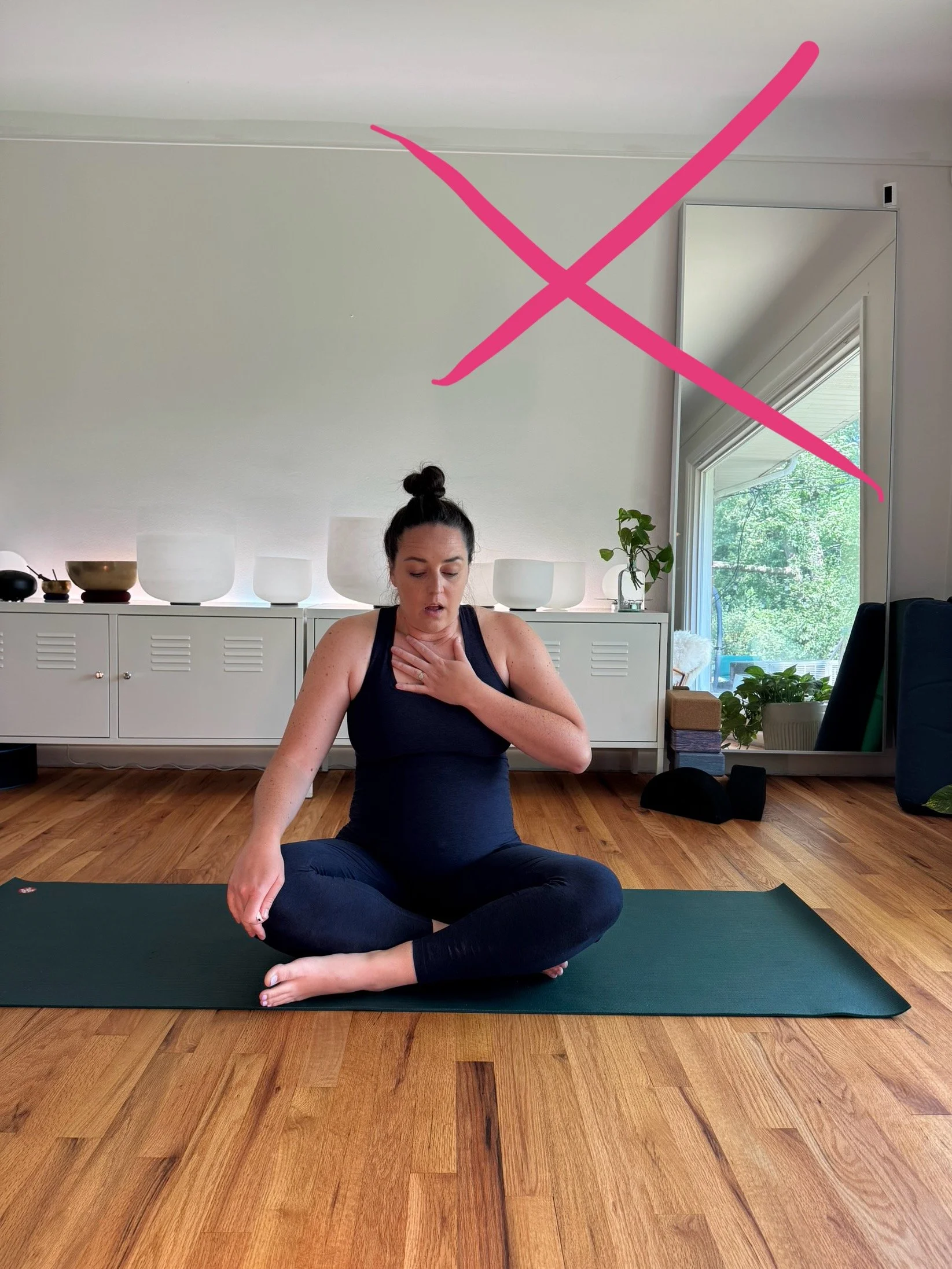Practicing Safely Through Pregnancy
The Do’s and Don’ts by Trimester
General Guidelines
Work to maintain fitness. Pregnancy is not the time to be striving for new PRs. Instead, aim for daily activity at a moderate pace. It is much better to have a gentle daily practice than to exert a high intensity practice 2-3 times a week. As a general rule of thumb, you should be able to maintain a conversation throughout your exercise. If you’re out of breath, you’re going to hard.
1st Trimester 0-13
No closed twists; open twists are okay
No deep backbends
No contracted ab work (situps, crunches and the like)
Avoid strain to your pelvic area
(my belly is fake, for educational purposes only😁 )
2nd Trimester 14-27 weeks
no prone positions; for a short time is okay; less than 1 minute
no strong inversions
caution around balancing postures
caution around intensity
3rd Trimester 28-40
Everything from above plus more caution
Listen to your body and back off from any painful movements always
YOUR BODY IS CHANGING
YOUR BODY IS CHANGING
See how pregnancy drives changes in your body and how that can affect your yoga practice
Cardiovascular
increase heart rate & pump volume
40% increase in blood volume
adaptive decrease in blood pressure
During pregnancy, your cardiovascular system undergoes dramatic changes to support the growing baby. Blood volume increases by about 30–50% to meet the oxygen and nutrient demands of the fetus and placenta. As a result, the heart must work harder—cardiac output (the amount of blood the heart pumps each minute) rises significantly, especially by the second trimester. To accommodate this increased load, the heart rate typically increases by 10–20 beats per minute. At the same time, hormonal shifts—particularly from progesterone—cause blood vessels to relax and widen, which lowers systemic vascular resistance and can lead to a temporary drop in blood pressure in early pregnancy. Over time, the body adapts to maintain a balance between adequate circulation for the mother’s organs and for the developing baby. These changes are essential but can also make pregnant individuals more sensitive to changes in position (like feeling dizzy when standing too quickly) and may contribute to common symptoms like swelling or shortness of breath.
Respiratory
lung volume increases
rib cage expanse
lung displacement by upward moving abdominal contents + baby
The respiratory system adapts to ensure that both the mother and baby receive enough oxygen. One of the earliest changes is an increase in tidal volume—the amount of air moved in and out of the lungs with each breath—which can rise by up to 40%. This is largely driven by increased progesterone levels, which stimulate the respiratory centers in the brain, causing a slight increase in breathing rate and a deeper inhale. As the uterus grows, it pushes upward against the diaphragm, slightly reducing the space for lung expansion. However, the body compensates so effectively that overall oxygen intake actually improves. These changes can make breathing feel different—many pregnant individuals notice they get winded more easily or feel a sense of breathlessness, even at rest. Additionally, there’s a drop in carbon dioxide levels in the blood, which helps create a favorable gradient for oxygen to move from the mother to the fetus. Altogether, the respiratory adaptations during pregnancy are finely tuned to support the increased metabolic demands and the growing needs of the baby.
Muscular/Skeletal
the hormone relaxin works to loosen connective joint tissue to allow for pelvic expansive through delivery
changes in the spinal column (????) Kyphosis and Lordosis, shift in balance
The musculoskeletal system undergoes a range of adaptations to accommodate the growing baby and prepare the body for childbirth. As the uterus expands and the center of gravity shifts forward, the spine compensates with an increase in lumbar lordosis—a deeper curve in the lower back—which can contribute to lower back pain. The abdominal muscles stretch and weaken to make room for the uterus, while the pelvic floor bears increasing weight and pressure. At the same time, the hormone relaxin increases significantly, softening ligaments and joints, especially in the pelvis. This added laxity helps prepare the body for labor and delivery but also increases the risk of joint instability and discomfort, particularly in the hips, lower back, and knees. Many pregnant individuals may notice changes in posture, gait (the classic “waddle”), and balance as their body adapts. These musculoskeletal shifts are normal but can benefit greatly from supportive movement practices like prenatal yoga, which help build stability, ease strain, and maintain functional alignment.
Endocrine
Multitude of hormones that cause changes
The endocrine system plays a central role in pregnancy, orchestrating a complex hormonal symphony that supports both mother and baby. From the very beginning, levels of human chorionic gonadotropin (hCG) rise rapidly—this is the hormone detected by pregnancy tests and is crucial for maintaining the corpus luteum, which produces progesterone in early pregnancy. Progesterone and estrogen levels soar, helping to maintain the uterine lining, relax smooth muscle tissue, and stimulate breast tissue growth. Progesterone also has a calming effect on the immune system, helping the body tolerate the developing fetus. Meanwhile, the placenta becomes a powerful endocrine organ in its own right, taking over hormone production and releasing others such as human placental lactogen (hPL), which helps regulate the mother’s metabolism to ensure a steady nutrient supply for the baby. Thyroid activity ramps up slightly, increasing metabolic rate, and insulin resistance often develops in the second and third trimesters—an adaptive response to keep blood glucose levels higher for the fetus. These hormonal shifts can influence everything from mood and sleep to skin and digestion, reflecting just how deeply the endocrine system is intertwined with the experience of pregnancy.
Neuromuscular
elevation of pain threshold and pain perception, especially in the 3rd trimester
The neuromuscular system also undergoes significant changes during pregnancy, affecting both nerve function and muscle control. As the body adjusts to weight gain, shifting posture, and hormonal changes, nerves—particularly in the pelvis and lower limbs—can become compressed or irritated. This may lead to symptoms like tingling, numbness, or shooting pain, especially in the hands (as seen in carpal tunnel syndrome) or down the legs (as with sciatica). The hormone relaxin, which increases joint mobility by softening ligaments, also affects neuromuscular coordination by reducing stability, requiring muscles to work harder to maintain balance and alignment. Combined with fatigue and altered biomechanics, this can contribute to slower reflexes and an increased risk of falls. Some women may also notice muscle cramps or twitching, often linked to changes in electrolyte balance or circulation. Despite these challenges, the neuromuscular system is incredibly adaptive, supporting the body as it prepares for the physical demands of labor and the recovery that follows. Movement practices that enhance proprioception, balance, and muscular endurance—like prenatal yoga or gentle strength training—can help maintain neuromuscular health and ease discomfort throughout pregnancy.
Emotional and Spiritual
fear, anxiety, body issues
Pregnancy often brings profound emotional and spiritual changes, as the journey into motherhood reshapes a woman’s inner world as much as her outer one. Emotionally, the surge in hormones—particularly estrogen and progesterone—can intensify feelings, leading to mood swings, heightened sensitivity, or unexpected moments of joy or sadness. But beyond the chemical shifts, many women experience a deepening of emotional awareness and a re-evaluation of identity, priorities, and relationships. The impending responsibility of nurturing a new life can bring both anxiety and awe, grief for old versions of the self, and a newfound sense of purpose or inner strength.
Spiritually, pregnancy can awaken a connection to something greater—a sense of being part of the sacred cycle of creation. For some, this manifests as a renewed relationship with faith, nature, intuition, or ancestral lineage. Time may feel slower or more meaningful. Ordinary moments—like feeling the baby kick or visualizing labor—can become spiritual rites of passage. This transformation often invites introspection and surrender, asking the mother to release control and trust in the unfolding process. Whether or not a woman identifies with a specific spiritual path, pregnancy has the potential to be a deeply soul-stirring experience—one that challenges, expands, and redefines her sense of self and connection to life.










